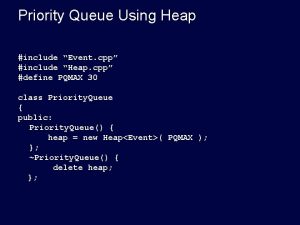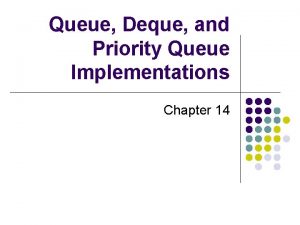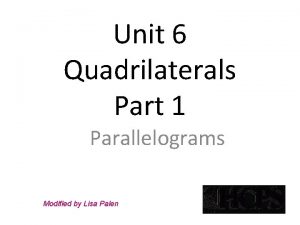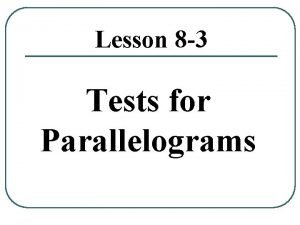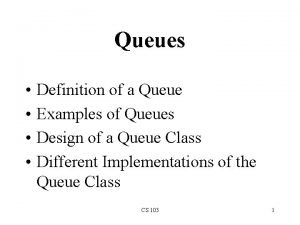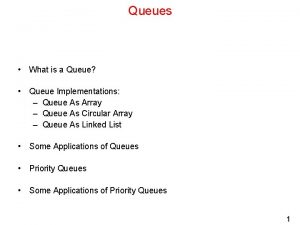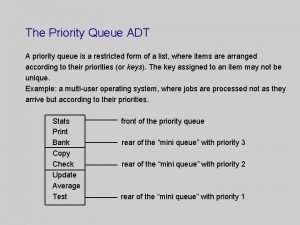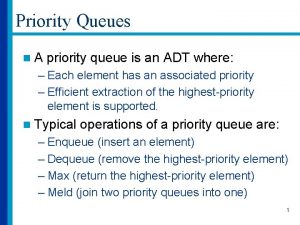Priority Queues Priority Queues Using a queue ensures

















































- Slides: 49

Priority Queues

Priority Queues Using a queue ensures that customers are served in the exact order in which they arrive. However, we often want to assign priorities to customers and serve the higher-priority customers before those of lower priority. For example, a hospital emergency room will handle the most severely injured patients first, even if they are not “first in line. ” A computer operating system that keeps a queue of programs waiting to use some resource, such as a printer, may give interactive programs a higher priority than batchprocessing programs that will not be picked up by the user until the next day, or it might give higher priority to short programs and lower priority to longer programs. A priority queue is a data structure that stores items along with a priority for each item. Items are removed in order of priority. The highest-priority item is removed first. If several items have equally high priorities, then the one that was placed in the priority queue first is the one removed first.

• Queues are a standard mechanism for ordering tasks on a first-come, first-served basis • However, some tasks may be more important or timely than others (higher priority) • Priority queues • Store tasks using a partial ordering based on priority • Ensure highest priority task at head of queue

Priority Queues: Specification Main operations • insert (i. e. , enqueue) • Dynamic insert • specification of a priority level (0 -high, 1, 2. . Low) • delete. Min (i. e. , dequeue) • Finds the current minimum element (read: “highest priority”) in the queue, deletes it from the queue, and returns it • Performance goal is for operations to be “fast”

Using priority queues 4 5 10 3 19 13 8 22 11 insert() delete. Min() 2 Dequeues the next element with the highest priority

Simple Implementations • Unordered linked list • O(1) insert 5 • O(n) delete. Min • Ordered linked list 2 • O(n) insert • O(1) delete. Min • Ordered array 2 • O(lg n + n) insert • O(n) delete. Min • Balanced BST • O(log 2 n) insert and delete. Min 2 10 … 3 3 5 … 10

Binary Heap A Heap is a Binary Tree H that stores a collection of keys at its internal nodes and that satisfies two additional properties: -1)Relational Property -2)Structural Property

Heap-order Property(Relational Property) • Heap-order property (for a “Min. Heap”) • For every node X, key(parent(X)) ≤ key(X) • Except root node, which has no parent • Thus, minimum key always at root • Alternatively, for a “Max. Heap”, always keep the maximum key at the root • Insert and delete. Min must maintain heaporder property Minimum element

Structure Property • A binary heap is a complete binary tree • Each level (except possibly the bottom most level) is completely filled • The bottom most level may be partially filled (from left to right) • Height of a complete binary tree with N elements is N=10 Height = 3 Every level (except last) saturated

Hear or Not? 9 9 5 4 tree 1 5 7 2 6 5 tree 2 5 7 tree 4 2 1 tree 3 9 2 7 1

• A binary tree satisfies the (min-)heap-order property if every child greater than (or equal to) parent (if exist). • A binary min-heap is a left-complete binary tree that also satisfies the heap-order property. 13 21 16 24 65 31 26 19 32 A binary min-heap 68 Note that there is no definite order between values in sibling nodes; also, it is obvious that the minimum value is at the root.


Binary Heaps: Array Implementation 06 1 • Implementing binary heaps. • Use an array: no need for explicit parent or child pointers. • Parent(i) = i/2 • Left(i) = 2 i • Right(i) = 2 i + 1 06 14 45 78 18 47 53 83 91 81 14 45 2 3 78 18 47 53 4 5 6 7 83 91 81 77 84 99 64 8 9 10 11 12 13 14 77 84 99 64

Binary Heap: Insertion • Insert element x into heap. • Insert into next available slot. • Bubble up until it's heap ordered. 06 14 78 83 45 18 91 81 47 77 84 53 99 64 42 next free slot 14

Binary Heap: Insertion swap with parent 06 14 78 83 45 18 91 81 47 77 84 53 99 64 42 15

Binary Heap: Insertion swap with parent 06 14 78 83 45 18 91 81 47 77 84 42 99 64 42 53

Binary Heap: Insertion • O(log N) operations stop: heap ordered 06 14 78 83 42 18 91 81 47 77 84 45 99 64 53

Binary Heap: Delete Min • Delete minimum element from heap. • Exchange root with rightmost leaf. • Bubble root down until it's heap ordered. 06 14 78 83 42 18 91 81 47 77 84 45 99 64 53

Binary Heap: Delete Min • Delete minimum element from heap. • Exchange root with rightmost leaf. • Bubble root down until it's heap ordered. 53 06 14 78 83 18 91 81 14 42 47 77 84 78 45 99 64 53 83 42 18 91 81 47 77 84 45 99 64 06

Binary Heap: Delete Min exchange with right child exchange with left child 53 14 14 78 83 42 18 91 81 53 47 77 84 45 99 64 78 83 42 18 91 81 47 77 84 45 99 64

Binary Heap: Delete Min • Delete minimum element from heap. • Exchange root with rightmost leaf. • Bubble root down until it's heap ordered. • O(log N) operations. stop: heap ordered 14 18 78 83 42 53 91 81 47 77 84 45 99 64

Priority Queue Implementation Heaps are the underlying data structure of priority queues

Running Time Comparison (Big Oh Notation) UNSORTED LIST HEAP INSERT c O(N) O(log N) DELETE c c O(log N) SEARCH O(N) MAXIMUM O(N) c c EXTRACT-MAX O(N) c O(log N) INCREASE-KEY c O(N) O(log N)

Binary Heap: Heapsort • Heapsort. • Insert N items into binary heap. • Perform N delete-min operations. • O(N log N) sort. • No extra storage.

Building a Heap A 4 1 3 2 16 9 10 14 8 7 4 • Build a heap starting from an unordered array 1 3 2 14 16 8 7 9 10

Building a Heap A 4 1 3 2 16 9 10 14 8 7 4 • The leafs are already heaps of size 1 1 3 2 14 16 8 7 9 10

Building a Heap A 4 1 3 2 16 9 10 14 8 7 4 • Go up one-by-one to the root, fixing the heap property 1 3 2 14 16 8 7 9 10

Building a Heap A 4 1 3 14 16 9 10 2 8 7 4 • Go up one-by-one to the root, fixing the heap property 1 3 14 Do that by running HEAPIFY 2 16 8 7 9 10

Building a Heap A 4 1 10 14 16 9 3 2 8 7 4 • Go up one-by-one to the root, fixing the heap property 1 10 14 Do that by running HEAPIFY 2 16 8 7 9 3

Building a Heap A 4 16 10 14 7 9 3 2 8 1 4 • Each HEAPIFY takes time O(height) 16 10 14 2 7 8 1 9 3

Building a Heap A 16 14 10 8 7 9 3 2 4 1 16 • Each HEAPIFY takes time O(height) 14 10 8 2 7 4 1 9 3

Building a Heap A 16 14 10 8 7 9 3 2 4 1 16 BUILD-HEAP(A) heap_size[A]= length(A) 14 For i = length(A)/2 downto 1 10 8 HEAPIFY(A, i) 2 7 4 1 9 3

Running Time of BUILD-HEAP • How fast does BUILD-HEAP run? ? ? • Here is a bound: • At most N = heap_size(A) calls to HEAPIFY • Each call takes at most O(log N) time • Therefore, running time is O(N log N) • Are we done?

Heapsort A 16 14 10 8 7 9 3 2 4 1 16 HEAPSORT(A) BUILD-HEAP(A) 14 10 for I = length(A) downto 2 exchange(A[1], A[i]) 8 heap_size(A)-- 7 HEAPIFY(A, 1) 2 4 1 9 3

Heapsort A 16 1 14 10 8 7 9 3 2 4 16 1 HEAPSORT(A) BUILD-HEAP(A) 14 10 for I = length(A) downto 2 exchange(A[1], A[i]) 8 heap_size(A)-- 7 HEAPIFY(A, 1) 2 4 16 1 9 3

Heapsort A 16 1 14 10 8 7 9 3 2 4 16 1 HEAPSORT(A) BUILD-HEAP(A) 14 10 for I = length(A) downto 2 exchange(A[1], A[i]) 8 heap_size(A)-- 7 HEAPIFY(A, 1) 2 4 16 1 9 3

Heapsort A 14 8 10 4 7 9 3 2 1 16 1 14 HEAPSORT(A) BUILD-HEAP(A) 8 10 for I = length(A) downto 2 exchange(A[1], A[i]) 4 heap_size(A)-- 7 HEAPIFY(A, 1) 2 1 16 1 9 3

Heapsort A 1 8 10 4 7 9 3 2 14 16 1 1 HEAPSORT(A) BUILD-HEAP(A) 8 10 for I = length(A) downto 2 exchange(A[1], A[i]) 4 heap_size(A)-- 7 HEAPIFY(A, 1) 2 14 16 1 9 3

Heapsort A 1 8 10 4 7 9 3 2 14 16 1 1 HEAPSORT(A) BUILD-HEAP(A) 8 10 for I = length(A) downto 2 exchange(A[1], A[i]) 4 heap_size(A)-- 7 HEAPIFY(A, 1) 2 14 16 1 9 3

Heapsort A 10 8 9 4 7 1 3 2 14 16 1 10 HEAPSORT(A) BUILD-HEAP(A) 8 9 for I = length(A) downto 2 exchange(A[1], A[i]) 4 heap_size(A)-- 7 HEAPIFY(A, 1) 2 14 16 1 1 3

Heapsort A 2 8 9 4 7 1 3 10 14 16 1 2 HEAPSORT(A) BUILD-HEAP(A) 8 9 for I = length(A) downto 2 exchange(A[1], A[i]) 4 heap_size(A)-- 7 HEAPIFY(A, 1) 10 14 16 1 1 3

Heapsort A 2 8 9 4 7 1 3 10 14 16 1 2 HEAPSORT(A) BUILD-HEAP(A) 8 9 for I = length(A) downto 2 exchange(A[1], A[i]) 4 heap_size(A)-- 7 HEAPIFY(A, 1) 10 14 16 1 1 3

Heapsort A 9 8 3 4 7 1 2 10 14 16 1 9 HEAPSORT(A) BUILD-HEAP(A) 8 3 for I = length(A) downto 2 exchange(A[1], A[i]) 4 heap_size(A)-- 7 HEAPIFY(A, 1) 10 14 16 1 1 2

Heapsort A 8 7 3 4 2 1 9 10 14 16 1 8 HEAPSORT(A) BUILD-HEAP(A) 7 3 for I = length(A) downto 2 exchange(A[1], A[i]) 4 heap_size(A)-- 2 HEAPIFY(A, 1) 10 14 16 1 1 9

Heapsort A 7 4 3 1 2 8 9 10 14 16 1 7 HEAPSORT(A) BUILD-HEAP(A) 4 3 for I = length(A) downto 2 exchange(A[1], A[i]) 1 heap_size(A)-- 2 HEAPIFY(A, 1) 10 14 16 1 8 9

Heapsort A 4 2 3 1 7 8 9 10 14 16 1 7 HEAPSORT(A) BUILD-HEAP(A) 4 3 for I = length(A) downto 2 exchange(A[1], A[i]) 1 heap_size(A)-- 7 HEAPIFY(A, 1) 10 14 16 1 8 9

Heapsort A 3 2 1 4 7 8 9 10 14 16 1 3 HEAPSORT(A) BUILD-HEAP(A) 2 1 for I = length(A) downto 2 exchange(A[1], A[i]) 4 heap_size(A)-- 7 HEAPIFY(A, 1) 10 14 16 1 8 9

Heapsort A 2 1 3 4 7 8 9 10 14 16 1 2 HEAPSORT(A) BUILD-HEAP(A) 1 3 for I = length(A) downto 2 exchange(A[1], A[i]) 4 heap_size(A)-- 7 HEAPIFY(A, 1) 10 14 16 1 8 9

Heapsort A 1 2 3 4 7 8 9 10 14 16 1 1 HEAPSORT(A) BUILD-HEAP(A) 2 3 for I = length(A) downto 2 exchange(A[1], A[i]) 4 heap_size(A)-- 7 HEAPIFY(A, 1) RUNNING TIME? 10 14 16 1 8 9
 Double ended queue in data structure
Double ended queue in data structure Priority queue using heap
Priority queue using heap Transform and conquer algorithm
Transform and conquer algorithm Priority queues: quiz
Priority queues: quiz Adaptable priority queue java
Adaptable priority queue java Applications of priority queues
Applications of priority queues Priority queue doubly linked list
Priority queue doubly linked list Deque and priority queue
Deque and priority queue Priority queue lower bound
Priority queue lower bound Priority queue abstract data type
Priority queue abstract data type Praveen
Praveen Contoh priority queue
Contoh priority queue Heap based priority queue
Heap based priority queue Priority queue order
Priority queue order The queue summary
The queue summary Double ended priority queue
Double ended priority queue Adaptable priority queue java
Adaptable priority queue java Min priority queue
Min priority queue Priority queue animation
Priority queue animation Burman's priority list gives priority to
Burman's priority list gives priority to Priority mail vs priority mail express
Priority mail vs priority mail express Entity integrity ensures correctness of the data in a table
Entity integrity ensures correctness of the data in a table Unit 6 quadrilaterals
Unit 6 quadrilaterals Proving that a quadrilateral is a parallelogram quiz part 1
Proving that a quadrilateral is a parallelogram quiz part 1 Scaling example
Scaling example Biogeochemical cycling ensures that
Biogeochemical cycling ensures that What is control m
What is control m Josephus problem java queue
Josephus problem java queue Java stacks and queues
Java stacks and queues Message queue in unix
Message queue in unix Erisone queues
Erisone queues Rtos mailbox
Rtos mailbox What are stacks
What are stacks Queue representation
Queue representation Jenis struktur data queue sering digunakan untuk
Jenis struktur data queue sering digunakan untuk Cqueue
Cqueue Exercises on stacks and queues
Exercises on stacks and queues Queues definition
Queues definition Unit 25 special refrigeration system components
Unit 25 special refrigeration system components Using system using system.collections.generic
Using system using system.collections.generic Queue stack c++
Queue stack c++ Queue adt
Queue adt Queue waiting time
Queue waiting time Cisco cuic
Cisco cuic China and imperialism
China and imperialism Replay queue length exchange 2010
Replay queue length exchange 2010 Multilevel queue scheduling
Multilevel queue scheduling Aps interconnection queue
Aps interconnection queue Advantage and disadvantage of queue
Advantage and disadvantage of queue Pvscsi queue depth
Pvscsi queue depth

